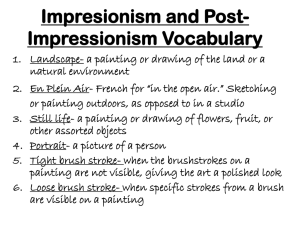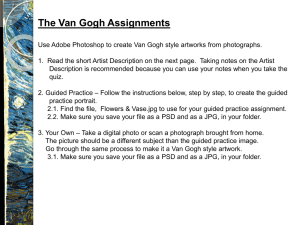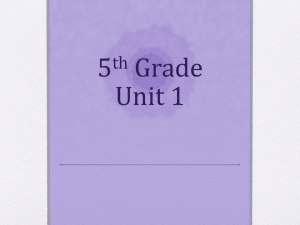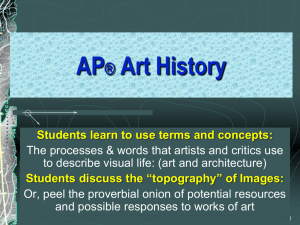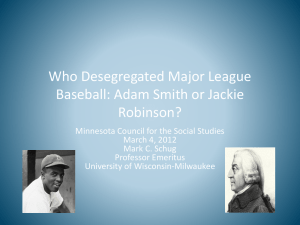EEAH Resources for Teaching Economics in US History
advertisement
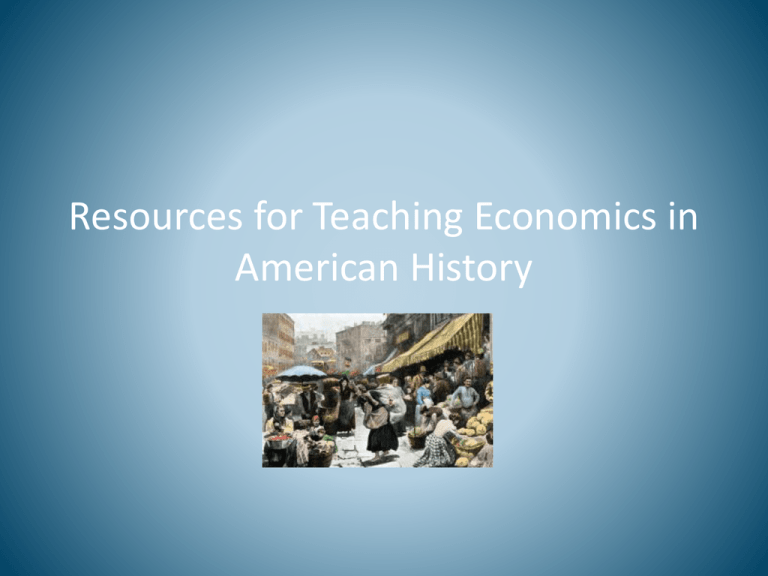
Resources for Teaching Economics in American History Features • Essay on the economic way of thinking. • 39 complete lesson plans – Economic history explanations – Detailed teaching procedures – All visuals and handouts are included – Linked to national economics and history standards • Uses an “economic mystery” approach to encourage students to practice economic thinking skills. • Includes multiple choice and constructed response assessments. • Published by the Council on Economic Education How to Order Focus Just click on: http://www.councilforeconed. org/ Art History Research The Van Gogh Family • • • • Obnoxious brother Dizzy Aunt Brother who ate prunes Brother who worked at a convenience store • Grandfather from Yugoslavia • Please Gogh • Verti Gogh • Gotta Gogh • Stop N Gogh • U Gogh Art History Research The Van Gogh Family • Cousin from Illinois • Magician uncle • Mexican cousin’s halfbrother • Constipated uncle • Ballroom dancing aunt • Chica Gogh • Wherediddy Gogh • Amee Gogh • Cant Gogh • Tan Gogh Art History Research The Van Gogh Family • Bird lover uncle • Nephew psychoanalyst • Brother who was a Beatle • Flamin Gogh • E Gogh • Rin Gogh • The nephew who drove a stage coach ----------- Wells-far Gogh The constipated uncle --------------------------------- Can't Gogh The ballroom dancing aunt ---------------------------- Tang Gogh The bird lover uncle --------------------------------- Flamin Gogh The fruit-loving cousin --------------------------------- Man Gogh An aunt who taught positive thinking ------------- Way-to-Gogh The little bouncy nephew ------------------------------ Poe Gogh A sister who loved disco -----------------------------Go Gogh AND.... His niece who travels the country in an RV....... : Winnie Bay Gogh Economic Episodes in American History: Wohl Publishing Features • 32 chapters focused on an economic episode • Chapter 1 provides an introduction to the economic way of thinking • All other chapters can stand alone • Complete Teacher’s Guide including answer to the Questions for Discussion, correlations to national standards, a teaching activity for each chapter, assessments including constructed response and multiple choice items for each chapter. • Available in multiple formats: print, online, customized Chapter Organization • Framing the Issue (with a personal story) • Key Economic Concepts (Box) • The Historical Context • The Economics of the topic • Historical Questions and Economic Answers • Primary Source • Then and Now • Complete Teacher’s Guide with summaries, standards, assessments and activities. Table of Contents • CHAPTER 1 How Can Economics Illuminate History? • CHAPTER 2 Why Did the British Colonies Succeed Economically—Without Finding Gold and Silver? • CHAPTER 3 Why Did John Harrower Sell Himself into Bondage? • CHAPTER 4 Why Did the American Colonists Fight When They Were Safe, Prosperous, and Free? • CHAPTER 5 How Did the U.S. Constitution Provide a Road Map to Economic Prosperity? • CHAPTER 6 Turnpikes, Canals and Railroads: What Did We Do Before Interstate Highways? • CHAPTER 7 Was Slavery a Market Institution? Table of Contents • CHAPTER 8 The Civil War and Lee’s Dilemma: Why Fight a War When the North’s Economy Was So Much Stronger? • CHAPTER 9 How Did the Civil War Change the U.S. Economy? • CHAPTER 10 The Homestead Act of 1862: Was Free Land Really Free? • CHAPTER 11 Did the Comanche and Other American Indians Favor Communal Ownership? • CHAPTER 12 Why Did Frank H. Mayer and His Fellow Hunters Kill Buffalo, Almost to Extinction? • CHAPTER 13 Did Railroads Cause the Economy of the Late 1800s to Grow? • CHAPTER 14 Hard Currency: Sound Money or Cross of Gold? Table of Contents • CHAPTER 15 Were the Robber Barons Robbers or Barons? • CHAPTER 16 Why Did the 19th-Century Monopolies Disappear? • CHAPTER 17 How Did Financial Panics Lead to the Establishment of an Independent Central Bank? • CHAPTER 18 Who Was the Titanic Baby and Where Was He Going? • CHAPTER 19 What Made the Roaring Twenties Roar, Economically: Real Growth or a Stock Market Bubble? • CHAPTER 20 Why Did a Mild Recession in 1929 Become the Great Depression of the 1930s? • CHAPTER 21 Was the New Deal Good for the U.S. Economy? Table of Contents • CHAPTER 22 The Economics of Union Membership: Solidarity Forever? • CHAPTER 23 Did Rosie the Riveter Win the Battle for Working Women? • CHAPTER 24 Why Did the Economy Grow after World War II? • CHAPTER 25 Who Desegregated Major League Baseball: Adam Smith or Jackie Robinson? • CHAPTER 26 How Did the Marshall Plan Become a Model for Foreign Aid Programs? • CHAPTER 27 What Were the Origins of the African American Middle Class? Table of Contents • CHAPTER 28 Why Did Communism Collapse? • CHAPTER 29 How Did the Economy Influence Presidential Elections in the Stagnant Seventies? • CHAPTER 30 Is the Information Revolution as Big as the Industrial Revolution? • CHAPTER 31 Is Free Trade Out of Date? • CHAPTER 32 Is the Growth of the Federal Government Good for the Economy? How to Order EEAH Phone: (866) 620-6942 Fax: (708) 534-7803 Email: wohlorders@warepak.com Or just click on www.wohlpublishing.com


